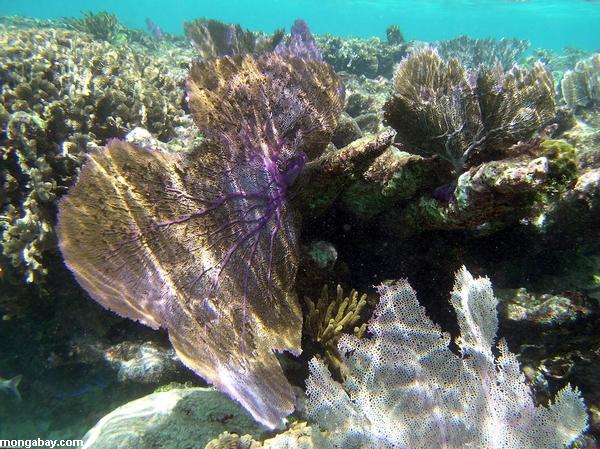Google Earth presents fish-eye view of coral reefs
mongabay.com
August 20, 2013
You can now visit up-close and personal some of the world's most imperiled ecosystems on Google Earth: coral reefs. The Google team is working with scientists to provide 360 degree panoramas, similar to Google street-view, to give armchair ecologists a chance to experience the most biodiverse ecosystems under the waves.
"Only 1% of humanity has ever dived on a coral reef and by making the experience easily accessible the survey will help alert millions of people around the world to the plight of coral reefs," says Ove Hoegh-Guldberg with the University of Queensland. Hoegh-Guldberg heads the Catlin Seaview Survey which brings cameras mounted to a manned vehicle to photograph the reefs. Last year the team did around 30 surveys in the Great Barrier Reef region, while this year they have expanded to the Caribbean.
But the technology has other potential beyond education and appreciation. Researchers hope to employ citizen scientists to identify marine species via images, helping to catalogue biodiversity on embattled reefs.
Coral reefs are threatened by pollution, coastal development, on-land deforestation, and overfishing. However the largest threat to coral reefs is burning fossil fuels, which is pushing marine temperatures up and causing to ocean acidification.
"Our results show that even under the most moderate climate change projections from the Intergovernmental Panel on Climate Change, most corals will struggle to survive and reefs will rapidly decalcify," says Hoegh-Guldberg, who is running a longterm project in Australia that measures how corals respond to rising temperatures and acidification in controlled conditions.


Sea fans on a coral reef off the coast of Mexico. Photo by: Rhett A. Butler.
Source: http://news.mongabay.com/2013/0820-hance-google-coral.html
You can now visit up-close and personal some of the world's most imperiled ecosystems on Google Earth: coral reefs. The Google team is working with scientists to provide 360 degree panoramas, similar to Google street-view, to give armchair ecologists a chance to experience the most biodiverse ecosystems under the waves.
"Only 1% of humanity has ever dived on a coral reef and by making the experience easily accessible the survey will help alert millions of people around the world to the plight of coral reefs," says Ove Hoegh-Guldberg with the University of Queensland. Hoegh-Guldberg heads the Catlin Seaview Survey which brings cameras mounted to a manned vehicle to photograph the reefs. Last year the team did around 30 surveys in the Great Barrier Reef region, while this year they have expanded to the Caribbean.
But the technology has other potential beyond education and appreciation. Researchers hope to employ citizen scientists to identify marine species via images, helping to catalogue biodiversity on embattled reefs.
Coral reefs are threatened by pollution, coastal development, on-land deforestation, and overfishing. However the largest threat to coral reefs is burning fossil fuels, which is pushing marine temperatures up and causing to ocean acidification.
"Our results show that even under the most moderate climate change projections from the Intergovernmental Panel on Climate Change, most corals will struggle to survive and reefs will rapidly decalcify," says Hoegh-Guldberg, who is running a longterm project in Australia that measures how corals respond to rising temperatures and acidification in controlled conditions.


Sea fans on a coral reef off the coast of Mexico. Photo by: Rhett A. Butler.
Source: http://news.mongabay.com/2013/0820-hance-google-coral.html








0 Comment :
Post a Comment
Thanks for your comment!